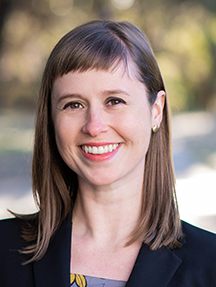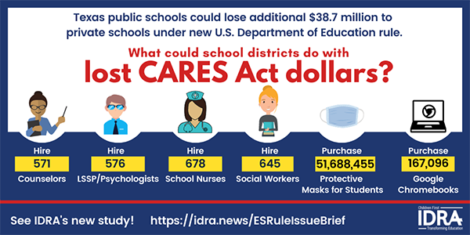• Chloe Latham Sikes, Ph.D. • IDRA Newsletter • September 2020 •


In January, the Department proposed new rules that subvert the foundational principle of separation of church and state. The rules would allow religious institutions to receive federal grants even if they use private, religious discretion to discriminate against who receives their services, such as members of the LGBTQ community or other religious denominations (ACLU, 2020).
In April, the Department granted excessive funds to charter school chains with ties to the Administration (Strauss, 2020). In particular, the IDEA charter chain received a $72 million grant despite multiple red flags about inappropriate use of past federal funds and incomplete performance reports.
In May, the Department leveraged its discretion to spend $180 million allotted under the CARES Act to create a grants competition for states to address students’ technological needs related to COVID-19. One measure calls for states to develop “microgrants”– a moniker for vouchers – that individuals can use for private education services and technology equipment. These microgrants allow inequitable diversion of public funds away from public schools. The Administration has prioritized microgrants and other voucher programs despite public opposition (NSBAC, 2020) and poor academic results for students (Spector, 2017).
In June, the Department instructed public school districts to forgo federal guidance on how to hand over their emergency COVID-19 relief funds to private schools based on the number of students from limited incomes. Since 2015, when the Every Student Succeeds Act (ESSA) became law, school districts were required to give to local private schools federal funds designated for serving high concentrations of students from families with limited incomes. But the Department issued a rule this summer attempting to require public schools to give away relief funds based instead on all students in private schools, regardless of their financial need. For instance, IDRA analysis showed that the new rule diverted an estimated additional $38.7 million from Texas public school districts to private schools, with charter schools keeping 100% of their federal entitlement (Craven & Johnson, 2020). A federal judge recently sided with public school advocates to block the new guidance from taking effect.


Also in June, the Department lauded the U.S. Supreme Court’s decision in Espinoza v. Montana Department of Revenue, which allows public funds to be spent in support of private religious schools even as public schools that serve the majority of the nation’s students remain underfunded and face an economic downturn. The Court found that a Montana rule prohibiting religious schools from participating in a tax credit scholarship program discriminated against those schools and the families who wanted their children to attend them. The Court’s decision opens the door for states to adopt or expand similar tax credit programs and other direct voucher programs. The ruling also empowers the Department to continue its push for “Education Freedom Scholarships,” a federal dollar-for-dollar tax credit for individuals and businesses that give money to private school voucher funds.
Each of these actions contributes to private education strategies that undercut public schools to instead funnel money to private schools that admit only a select few. Undermining public schools’ access to federal funding, including emergency relief funds, is to our collective detriment. Public schools remain the only free and open educational system that legally must serve all students, regardless of disability, race, ethnicity, gender, citizenship, or religion.
The current COVID-19 crisis has made public schools’ pivotal roles in our communities clearer than ever through their responses to feed our children, provide mobile hotspots in neighborhoods, and promote legal and healthcare information to families. Public schools do not just serve their enrolled students – they serve the whole community.
The pandemic also makes evident that we are all connected. Our personal health is only as good as our neighbor’s health, and our children’s educational success depends on their peers’ success. With much uncertainty, one thing is clear: the only real way forward is to support steps toward the public good.
Resources
ACLU. (January 16, 2020). ACLU Comment on Proposed Trump Administration Regulations on Religious Freedom, press release. New York, N.Y. American Civil Liberties Union.
Craven, M., & Johnson, R. (2020). Cutting Public School Relief Funds to Subsidize Private Schools – Issue Brief. IDRA.
NSBAC. (2020). National Poll Shows Strong Voter Support for Public Schools. Washington, D.C.: National School Boards Action Center.
Spector, C. (February 28, 2017). Vouchers do not improve student achievement, Stanford researcher finds, Stanford News.
Strauss, V. (April 27, 2020). IDEA charter school network landed grants with political help from Education Department, congressman says, Washington Post.
U.S. Department of Education. (January 16, 2020). U.S. Secretary of Education Betsy DeVos Announces Proposed Rule Regarding Equal Treatment of Faith-Based Education Institutions, Provides Updated School Prayer Guidance, press release. Washington, D.C.
U.S. Department of Education. (June 25, 2020). Secretary DeVos Issues Rule to Ensure CARES Act Funding Serves All Students, press release. Washington, D.C.
U.S. Department of Education. (June 30, 2020). Secretary DeVos on Espinoza: Religious Discrimination is Dead, press release. Washington, D.C.
Chloe Latham Sikes, Ph.D., is IDRA’s deputy director of policy. Comments and questions may be directed to her via email at chloe.sikes@idra.org.
[©2020, IDRA. This article originally appeared in the September 2020 IDRA Newsletter by the Intercultural Development Research Association. Permission to reproduce this article is granted provided the article is reprinted in its entirety and proper credit is given to IDRA and the author.]


